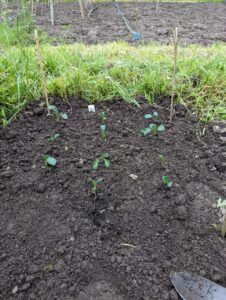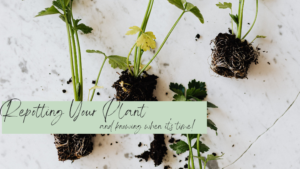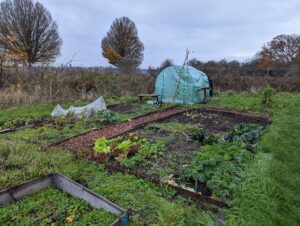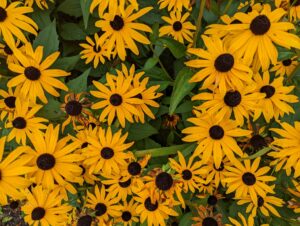Options for sowing in June are plentiful! We’ve finally hit summer, and the weather is warming up.
Along with the warm weather comes much faster germination; making June a great month to start off some kitchen favourites.
To start us off, I’m going with one of my new favourites.
I can’t get enough of kale, and if I’ve said it a hundred times, chances are I’ll say it at least a hundred more.
In fact, I love it enough to snack on it at random as I pass the fridge.
I’ve already started a bunch of different Kale varieties, but for a more continuous harvest I’ve sown plenty more to keep me going!

Kale is slow to grow, and many find it easiest to sow their kale seeds into seed trays or pots before carefully transplanting into their final beds in the garden – this way, it won’t take up valuable growing space that could be used for something else during this peak growing time.
Sow seeds around a centimetre deep into your choice of compost, and water well. When they’re ready to transplant (I try to wait until there are at least three or four true leaves), and make sure you net over your seedlings to prevent pests.
Peas are one of my favourite vegetables and are something I’ve already sown multiple times over the last couple of months.
Prolific growers, peas can be sown directly into the ground or in pots – there are so many dwarf varieties that make growing peas in any size garden successful!
A rookie mistake, I managed to direct sow two full rows of Blauwschok peas and didn’t bother netting them. They germinated, and to my excitement started to grow… and then got pecked at by the birds. Amazing.

Fortunately, I had plenty of seeds left and managed to start some more in containers in the garden to transplant out later (AND NET!).
That was a couple of weeks ago now, and I want to make sure that I extend my pea harvest into early autumn. Because of this I’ll personally be succession sowing peas every week or so through the rest of June through to the middle of July.
The best thing about peas is that they store well, so any I don’t pick and use fresh I’ll toss into large glass jars and store in the freezer until I’m ready to eat them.
Sow peas around 3cm deep into well draining soil, and cover to avoid bird attacks.
Kohl Rabi is such an unusual vegetable that I’d never heard of this time last year.
I noticed in my previous sowing at the beginning of May, that Kohl Rabi has an excellent germination rate and most of my seed modules were full!
I managed to prick out and transplant all of the seedlings into their own modules, but I did lose a few.
To make sure I have plenty of kohl rabi throughout the season, I’ll be sowing some more this week.
Sow your kohl rabi seeds around 2cm deep in finely prepared soil. Since last time I used two to three seeds per hole (two or three holes per module!) and had a great success rate, I’ll only be planting one seed per module this time around.
I’ll plant out into the ground when they’re big enough to handle and keep the roots moist; kohl rabi don’t like to dry out.
As we eat the bulbous stem part at the bottom of the plant, it’s super important to plant the modules out into the soil at the exact depth that the plant is in the compost.
If not, the edible stem will be partially hidden underground and will be susceptible to rot.

I’m growing a second lot of potatoes purely by chance.
My first crop are well under way at the allotment, but I have a horrible habit of leaving potatoes in my cupboard for too long, and then they start to chit.
Meaning, I had a good amount of potatoes that were ready to throw into the ground and start off a second crop.
I see lots of people chopping up their potatoes and spacing them out through their soil and… I just don’t have the energy for that! I love potatoes but I don’t tend to eat that many.
It might not be the best advice, but I’m very much a ‘throw them in the ground and hope’ potato grower. The most effort I go to is ‘earthing up’ the plants when I remember to.
Earthing up is covering the new potato shoots up with more compost and soil to extend the roots of the plants and to make sure the growing potatoes aren’t exposed to the sunlight – they will go green… and they will be poisonous to eat.
Nasturtiums are gorgeous, edible flowers with beautiful, distinctive foliage!

You can eat the flowers, the leaves and the seeds, making this multifunctional flower a perfect addition to your kitchen garden.
Nasturtiums are also a great pest deterrent. A great companion plant for your brassicas; caterpillars are attracted to their leaves and will usually choose to chomp down on these rather than your broccoli leaves.
While nasturtiums need full sun to partial shade to grow, strangely, your plants will flower best in poor, but free draining soil.
Chard is such a gorgeous vegetable and adds a bright splash of colour to your beds.

Quite often grown as a cut and come again crop, chard can be harvest multiple times throughout the growing season. The best thing about this is that you only really need to sow the seeds once for a long harvest.
Saying that, I do have some that were sown in May; and I will be sowing some more this week!
In fresh compost in trays or modules, you should sow chard seeds thinly at around two and a half centimetres deep. Alternatively, you can sow straight out into the soil.
Much like peas, netting chard once planted out is the best way to prevent your crops from being pecked at!
And last on this list, but absolutely not least, are carrots.
Everyone knows what a carrot is so I won’t bore you with any details! This year I’ve already started some regular orange varieties (of which I’ve completely forgotten), and I’ve tried the rainbow variety ‘Harlequin F1’.
So far, we have lots of tops showing up! So let’s cross our fingers that things are happening under the ground.
Carrots are a long taproot that grow straight down into the soil, but they can’t do that if the ground has lots of obstacles such as stones.
For super straight carrots, try sowing your seeds in a fine compost inside toilet roll tubes – I’ve even seen people use pieces of drainpipe to keep their carrots and parsnips straight!
Finely prepare the soil before sowing for best results, but honestly, I don’t mind a wonky carrot.
Sow your carrots very thinly around a centimetre deep into the soil – in containers or sown directly into the ground – and be patient, as they can take a while to germinate.
Maincrop varieties of carrots such as ‘Autumn King 2’ last really well if kept in the ground, and you can keep harvesting sometimes until January! Succession sowing every couple of weeks will keep you in carrots for longer. 
Of course, this isn’t an exhaustive list of what I’m sowing this month. If I put everything here you’d be reading for a very long time!
Seed Varieties I'm Sowing in June
- Cabbage – Red Drumhead
- Carrot – Harlequin F1
- Carrot – Chantenay Red Cored 2
- Climbing Bean – Cobra
- Courgette – Black Beauty
- Dwarf French Bean – Opera
- Kale – Dwarf Green Curled
- Kohl Rabi – Olivia F1
- Pea – Blauwschok
- Pea – Petite Provencal
- Pea – Kelvedon Wonder
- Pak Choi – Colour and Crunch F1
- Spinach – Perpetual
- Spinach – Renegade F1
- Sweetcorn – Incredible F1
I am so excited for another season of growing some of my favourite varieties!
Between the growing and getting the allotment plot into shape, it’s looking like I’m going to have a very productive summer!
Are you growing any of these varieties this month? Or are you growing any other varieties?! I’d love to hear from you in the comments!
As always, stay Wild and join me next time,
Althea x



